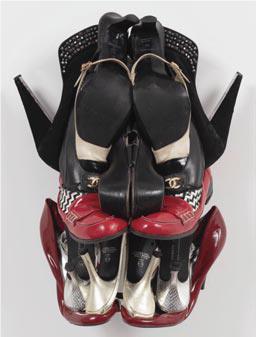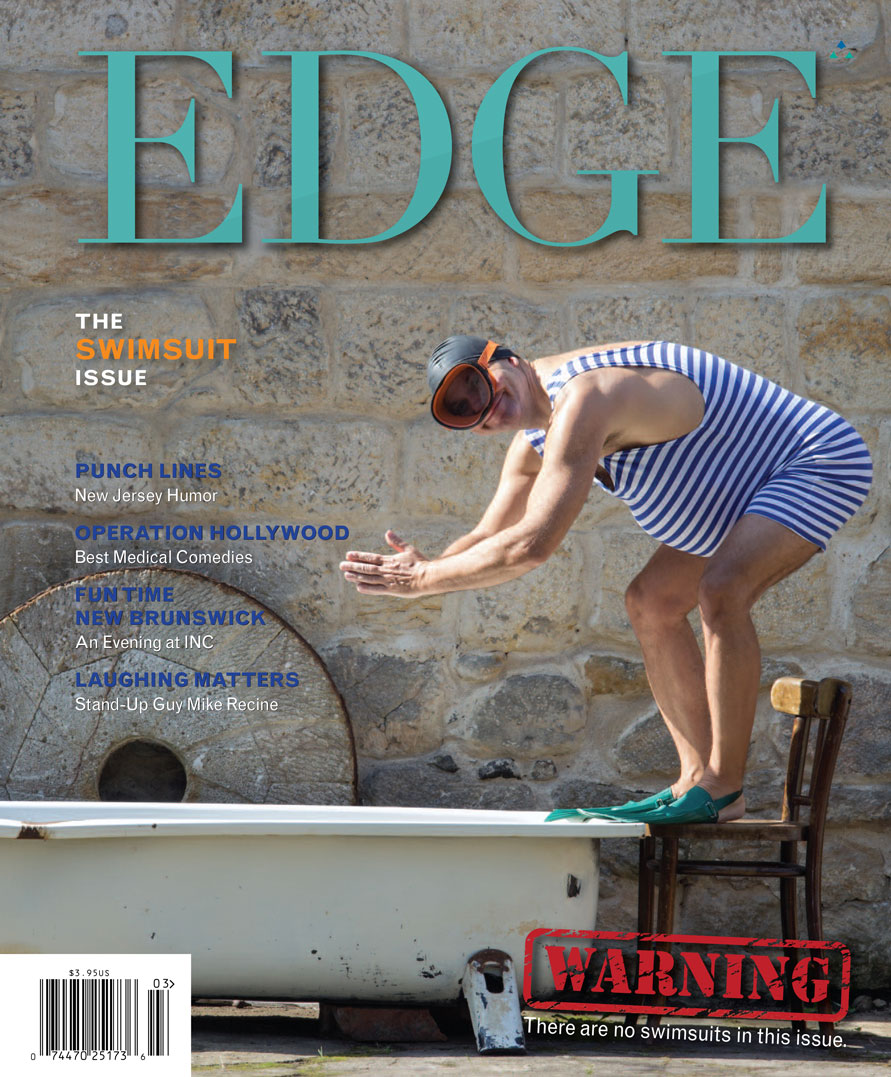New Jersey’s contributions to American popular culture are historically significant and meticu-lously documented, if not always fully appreciated in real time. Kevin Smith is practically the embodiment of real time. He is in the moment and of the moment, and that has defined his work as a film maker, podcaster and all-around multi-dimensional entertainment visionary. Clerks III, which debuted in September at an historic Jersey Shore movie theater he now owns, is the latest chapter in a three-decade career that has included critically acclaimed films, innovative live tours and podcast mega-success—punctuated by a near-fatal heart attack. The grassroots success of Smith’s first effort, Clerks, taught him valuable lessons about the movie business and the importance of forging a personal connection with his audience. Gerry Strauss asked Kevin to explore the roots of his fascination with film and examine how building connections —with actors, directors and fans—has enabled him to keep moving forward in dynamic, surprising and impactful ways.
EDGE: I admire the passion with which you stay connected with your New Jersey roots. Now that extends to the theater you’ve bought in Atlantic Highlands.
KS: It was one of my hometown theaters where I grew up. We’re coming up with this big mural to put into the lobby that’s got all the people from New Jersey who became successful. Look, there’s Tom Cruise, he was here once, and DeVito and Nicholson and Brittany Murphy. The idea of some kid coming into theater looking up and being like, These people came from New Jersey? Maybe I’ve got a shot—it takes me back to when I was a kid.
EDGE: How so?
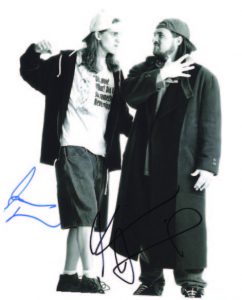
Upper Case Editorial
KS: When anybody would reference New Jersey in a movie or TV show, it was like, They know we exist. You felt positively cosmopolitan. You felt like you were part of the conversation. It was thrilling. I think that’s what I’ve always been trying to accomplish, to be part of the conversation. And I found that Jersey is an excellent conversation-starter worldwide. It carries with it credibility that other places don’t necessarily have. If I was from Rhode Island, it wouldn’t make much of a difference.
EDGE: I was thinking about films from my youth with a New Jersey connection, like The Karate Kid, and then realized the first few minutes of that movie they were getting the heck out of New Jersey.
KS: Yes! [laughs] Most Jersey origin stories have people leaving the state. That was one thing I was always proud about. My characters were content to stay within state.
In Clerks II, the plot hinged on whether or not Dante’s going to move away to Florida, and then ultimately he decides to stay. So yeah, New Jersey is in my DNA, man. I absolutely adore the state. It adds this weird layer of working-class credibility—which I think Bruce and Bon Jovi are kind of responsible for—that I have been benefiting from, and it has been absolutely magical. Being from New Jersey has sometimes been the only thing that’s kept my career alive.
EDGE: How do you think storytelling became part of your DNA?
KS: My journey with self-expression, for lack of a better word, began because of a Jersey Girl—specifically, my sister Virginia. I found a composition notebook under her bed when I was about five or six years old. I opened it up and the front page was a drawing of her and her friends kneeling around a cellar door. The title was The Secret of the Cellar Door. “What is this?” I asked. She said, “This is a book that I’m writing. It’s a story about me and my friends on an adventure.” I was like, “You can’t just write a book. You’ve got to ask for permission from the government…we have a library card and Anybody can write whatever they want at any time.” That really captured my imagination. The family had this big electric typewriter, this thing you plugged in and it hummed and it sounded official, and it was very powerful. Once I learned how to use it and tell a story, that electric typewriter became one of my best friends. the flag is on it, and the eagle. It’s official.” She goes, “Look, not every book looks like the books in the library, and you don’t have to get ‘permission’ to write, ever.
EDGE: When did you become conscious of movie making?
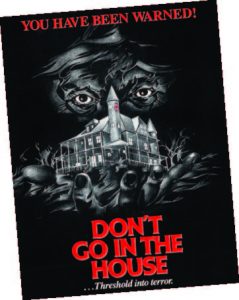
Film Venture Intl
KS: There was a movie called Don’t Go into the House that was shot in our neck of the woods, in Atlantic Highlands—including in front of that movie theater that I’m buying. It was a horror movie and the house that represented the killer’s lair—where he would bring women and chain them up and then use a flame thrower on them—is now the Historical Society of Atlantic Highlands. When we were kids, you would watch that movie and you’d be like, that’s here. I could bike to that house. That’s real, that exists. Little tangible moments like that.
EDGE: Nothing locally in the way of influences or role models?
KS: No. The role model had to come from outside of the state: Richard Linklater. When I saw Slacker I was like, Wait, you could be in nowhere, Texas, and make a movie? I didn’t know it was Austin [laughs]. I didn’t realize Austin was the capital of Texas. But a little ignorance went a long way because, when I saw the movie, I was like, This guy making a movie in Texas means that I can make a movie in New Jersey. It was saying that you ain’t got to be from New York or Los Angeles—make it up in your world. He made Austin the backdrop of the city, almost the main character. I was like, where I live is interesting and I’ve got that whole convenience store. So he inspired me more than anybody.
EDGE: Do you take pride in the fact that you’re now serving that role, inspiring up-and-comers?
KS: I love that. Money was never the big driver for me. Don’t get me wrong, I’m not a communist, I’m a capitalist as much as the next guy, but it has never really been the motivator. The motivator at first was for people to hear my voice, my stories, my opinions. Now the driver is the people that you inspire along the way. Richard Linklater did it for me. He wasn’t looking for me. He wasn’t thinking about me. But his art made me believe that maybe I could do something. The same with Spike Lee. I recently saw Spike Lee in Minneapolis at VeeCon, the big NFT convention. We share mutual friends. I told him, “When you started your journey, when you made She’s Gotta Have It, and even before that when you went to NYU, I know you weren’t trying to reach me. But you did and I can’t thank you enough, it launched my ship.”
EDGE: How did he respond?
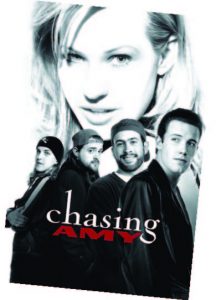
Miramax
KS: He said, “The professor teaches all students, Kevin. So if I reached you, then that was the point. Then I did my job.” Later he said, “We’re still here. We’re still doing it.” That “we” meant the world to me. That made me feel like such a professional. Seeing Spike take off with She’s Gotta Have It, that was fuel for me later on. It’s no coincidence that She’s Gotta Have It was a black-and-white movie and so was Clerks.
EDGE: It strikes me that the Clerks franchise is the thing you go back to when you’ve got something to say from the heart. Are these movies most personal work among all of the films you’ve done?
KS: I would say of everything I’ve done, the Clerks movies always strike closest to home. Chasing Amy runs second. There’s personal stuff in all the movies, but Clerks started me on this path.
EDGE: You told that story in the first movie so naturally.
KS: It was easy to tell the story because I was in that world. I worked at that convenience store. I was a guy who tended register, man, at a bunch of different convenience stores. So I knew retail and I knew what it was like to deal with customers. When we made Clerks II, twelve years after the first one, at that point I had a full-blown movie career. I didn’t know about retail anymore, so it had to be infused with something else altogether, because it lacked that personal edge of knowing what it’s like to be an employee. The boys had to go on a journey that was kind of similar to mine, where, by the end of the movie they realized, Oh my god…we can be our own bosses instead of just working for somebody else. But Clerks III is super personal because not only does Randal have my heart attack, but then the boys go on and make my movie. They get to make their version of Clerks. That’s been the formula for Clerks since the beginning: take my personal life and fictionalize it to some degree. Clerks III was like midlife crisis fantasy camp. I got to go back to the job that I have a very complex relationship with. When I worked at Quick Stop, I didn’t want to work at Quick Stop. I wanted to be any place else—until 10:30, when we locked the doors and I would hang out inside Quick Stop ’til three, four in the morning with my friends. It was a clubhouse. I loved the place…I just didn’t like working. So I got to go back to Quick Stop all summer when we were shooting the movie, but in the best way possible. I would literally walk in and out of the store and walk in RST Video like I used to in the late ’80s and early ’90s. But I didn’t have to wait on customers and I didn’t have to be there. I was there by choice. And when we were done making pretend that we were working, we all left, walked away. I didn’t have to mop the floors like I used to back in the day. It was the best possible version of working at Quick Stop.
EDGE: You’ve worked with a number of different actors who were just arriving in the film world—Ben Affleck and Jason Lee come to mind—whom you helped shepherd into becoming the stars they became. Do you look back at those times with pride, knowing that you were able to be a part of that development?
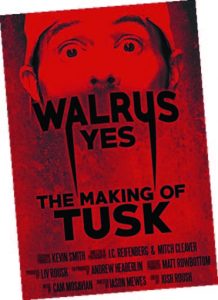
Smodcast Pictures
KS: There was a time where I was the big story, so I was able to help Ben and Jason and others. Now I’ll never be as big a story as Ben. So it actually helps me that I was like, “Here, man, let me jump in and let me try to get your movie made” because I had juice back then. The older you are and the longer one stays in the business, the less they give a crap about you…but…because I have people on my side who I’ve been working with since the beginning, since I believed in them before they were famous, I’m able to whip out some cool people to put in a flick. It makes you look hip to some degree. It makes people think, Oh, if that person will still work with them, I guess he’s still relevant. But for me, it’s just like, these are cats that I believed in dearly. And when they get famous you’re like, I knew it! I knew I was right! They’re special and you feel special and smart because you got to identify that quality before anybody else. It’s a sense of authorship. I think of people like Brian O’Halloran and Jeff Anderson who played Dante and Randal in the Clerks movies, Ben Affleck and Jason Lee who played Holden and Banky in Chasing Amy, or Ben and Matt Damon who played Bartleby and Loki in Dogma. Those actors will inhabit those performances for the rest of my life; they are the co-architects of my entire world. Also, it’s nice that they got famous because it certainly makes it easier for me to convince people to let them be in my movies.
EDGE: Initially there was resistance?
KS: In the beginning, I would have to drop the budget to get them into my movie. Chasing Amy was meant to be a $3 million movie. They wouldn’t let me make it for three million with Ben and Joey and Jason, so I dropped it to 250 grand, and then they were like, “Go ahead…now you can make it with your friends.” I hate to make it seem like war—because making art is not like war at all—but I was in the trenches with these kids, making my dreams come true. They were laying the track with me, so forever they maintain in an incredibly special place in my life. So I’ll always reach out to them to try to bring them back into whatever I’m doing. But even if I never worked with them again, the sense of pride I feel when I watch them kind of ascend. It is breathtaking. It’s fun. Ladies and gentlemen, meet these cats that I find really interesting. They’ve become part of the establishment now, part of the business. It’s really cool.
EDGE: Do you think much about your legacy?
KS: I do. The older one gets, the more it’s like, look, it’s paid all my bills and I’ve been happy for the last 30 years, but has anything I’ve done made an impact, or is it just going to go with me when I drop dead. Did I make my mark? You didn’t think about it when you’re making your mark because you’re just focused on doing it. I think I’ve done enough things where it’s like, Oh yeah, they’re going to know you were here. Never mind the actors we’ve worked with who have gone on to be huge movie stars, or dopey stuff like me and Mewes getting our handprints in the cement at Grauman’s Chinese Theatre. Love or hate my movies, you can’t deny that they happened, you can’t deny that we were a part of [the culture]. So that makes me happy, knowing that for a few minutes after I drop dead, my work may go on without me. I mean, there seems to be no expiration date on Clerks.
EDGE: Does that surprise you?
KS: It still blows my mind to this day.
EDGE: Have you ever fallen out of love with movie-making?

Allan Amato
KS: Between Red State and Tusk, I took three years off. While I was promoting Red State in 2014, I kept saying, “I’m retiring. This is it. I’m doing a Soderbergh, man. I’m retiring.” Rolling Stone did a big article on it and my mother called me up crying. I had reached a point where I was really disenchanted by how much it costs to release a movie. I knew how to control the cost of making a movie. I made Clerks…I know how to get it real cheap. But you could make the movie as cheap as possible and then you hand it over and they pour $20 million in marketing all over it. That’s how movies don’t get made! I was like, “I don’t have that kind of audience. You don’t need to spend that.” I was so tired of them talking about how We’re going for the widest possible audience. I’m like, “Why? I’m an acquired taste.” If I could admit that, why couldn’t they? I’m not ever going to make a blockbuster, man. I’m an indie film maker. I make Kevin Smith movies and there’s a ceiling to that. Finally, I was like, I don’t want to do this. I’m going to take the movie out on the road myself and not spend any money on marketing. Let’s see if that’s possible. And that was the root of what we do now, the root of the Jay and Silent Bob Reboot Road Show Tour and also the Clerks III Convenience Tour that we’ve got coming up. Anyway, during those three years off I did a ton of podcasting.
EDGE: And how did the podcasting feed into what’s happening now?
KS: I had been touring by myself for years at that point, just standing on stage and talking. But then I started going out there with my friends and these podcasts that I’d been working on. That was where I built the live-show business that I have with my friends. When we go on tour, it’s a blissful experience. People pay $100 to “watch a movie with Kevin Smith.” I am both the celebrant and the celebrated at the same time—I get to connect with the audience. I found something that works for me that makes me happy. During that three-year gap of me not making movies, I had to rebuild my business and all I did was devote myself to podcasting and live shows, which were very successful. And eventually, podcasting led back to film.
EDGE: To Tusk?
KS: Right. Scott Mosier and I were doing episode 259 of SModcast, which was called “The Walrus and the Carpenter,” telling this ludicrous story that we’d read online about a guy who was offering you a room for rent in his house. You’d pay nothing, but for two hours a day you had to dress up in a very realistic walrus costume. So we [brainstormed] this movie just fooling around, going back and forth, and I was like, You know what? That ain’t a joke. That’s a legit movie. So the thing that brought me back to movies was the desire to see a thing that nobody was ever going to do. On the podcast I asked, “Where are all the brave filmmakers who would make this man-to-walrus transformation? Where are the guts?” And then I realized, you used to be a gutsy filmmaker. Why don’t you do it? That’s why, spiritually, I consider Tusk to be the “sequel” to Clerks. Clerks was a movie that was made without thinking about critics, not thinking about box office, not thinking about film festivals—I didn’t even know about film festivals. I just wanted to see the movie. Tusk brought me back into movies and that passion has stayed reignited ever since.
EDGE: Did the heart attack you suffered four-plus years ago help reignite your passion, too?
KS: It sure upped the ante. When you almost die, suddenly you’re like I’ve still got a bunch of things I want to do. I just wasn’t done talking yet.
Editor’s Note: The Atlantic Moviehouse had its gala opening in September. For photos from that event and more on Kevin Smith’s plans to use the space as a multimedia venue, go to edgemagonline.com and click on his Q&A.
Stirring things up
Holiday entertaining is more meaningful when kids get in on the cooking.
Enjoying time and food with friends and family is one of the true pleasures of the holiday season. For young children, it offers a chance to get to know all the grown-ups better, and also to show off how “grown-up” they themselves have become since the last holiday gathering. Whether your family is hosting a party or attending as guests, some kind of food is bound to be involved, including main courses, side dishes, appetizers, salads and desserts. Oftentimes, parents discourage their kids from helping out with party-food production, especially the younger ones. As a mom who’s been cooking with her children for a long time, I completely understand—kids can be messy, require close supervision, and you’ll have to be cautious about what they are working on.

Photo by Brianne Grajkowski
But I also know that not including your children from this process is a major missed opportunity.
Cooking with your kids—or grand kids, if you have them and they are old enough—can be both fun and educational. It teaches them to be creative and explore new flavors. It teaches measurements, math, and science. It helps with reading, as kids learn new words from the recipes and lists of instructions. And when kids learn how to cook for themselves, they are also learning how to care for themselves, which is something all parents want for their children.
In addition, if they are put “in charge” of a party dish, the positive reinforcement they receive watching loved ones enjoy their creation is something that will last for a lifetime. Kids aren’t wired to be spectators; they are born participants.
With all this in mind, I gathered a handful of recipes that you can cook with your kids in the run-up to your next holiday gathering. The recipes are kid-friendly and approachable, but they aren’t “kid food.” They are small-dish appetizers that are meant to be special treats that should disappear quickly off the plate. They may even hear loud exclamations of delight and surprise: You made this? No way!…You did this by yourself? Impossible!…These are the best things at the party!
Safety First
Before we get to these party recipes, the most important thing you’ll need to keep in mind when cooking with kids is kitchen safety. I have found there are three components to cooking  safely: Listening, Timing, and Supervision:
safely: Listening, Timing, and Supervision:
- Listening. I’ve always told my kids that the first rule of cooking is listening. If they are having a hard time listening, then it isn’t the best time for them to cook or help out. I will ask them to sit down at the table until they are ready to move on. I find this to be the most helpful rule while cooking and learning together so that they remain safe.
- Timing. Safe cooking is fun cooking so, as a parent, it’s your job to know when it’s a good time for you and your child to cook together. If you’re in a hurry or starving, save your cooking together for another time. You both want to be ready to learn and enjoy your time together.
- Supervision. The third rule of safe cooking with your child is knowing how and when to supervise. The three areas of the kitchen that I think need the most supervision are when using A) a real knife, B) a stand mixer and C) anything that could burn them. In these areas, I am always with them at their current level of cooking. Once you’ve watched over them several times, use your best judgment for when you feel your child is ready to use these items with minimal supervision.
Getting Started – Practice makes perfect. Cooking together can have a learning curve, so it’s a good idea to test-drive a recipe with your children days or even weeks before the big party. Don’t be discouraged if the first few attempts don’t go exactly as planned. Keep trying until you find a rhythm together. Learning at the start will be the most challenging. Here are some tips and tricks for how to begin:
Start small. A good age to start teaching kids about cooking is when they are two to four years old, when they can help with easier tasks like pouring ingredients into a bowl and stirring. Even at that age, they can claim authorship of a dish even if you ended up doing the bulk of the work. When my kids were young, I encouraged them to cook with me all the time. One of their favorite cooking tasks was using the pastry brush to “paint” olive oil onto veggies or tomato sauce onto pizza dough.
Be patient. Kids will make a mess. Also, it will take longer to cook the dish than if you were cooking on your own. That’s okay because, as your child is learning, it is important to remember to have fun.
Start simple. The five recipes in this story are best suited for kids with a little experience in the kitchen, but you can help guide them. You’ll be interested to know that they are pulled from a book of 101 recipes that was published this fall, entitled Cooking with Kids. As a rule, easy recipes have few ingredients and don’t generally involve a lot of steps or complicated tasks. Some of the recipes in this story involve either a knife, high heat, or both. You can use a kids’ knife set or do that part yourself. If you sense any fear or potential for real danger, be sure to step in, but once you demonstrate how to do something safely, I think you’ll be surprised how quickly kids pick up the skill.
Pre-read the steps. As a kitchen supervisor, review all the steps of a chosen recipe with the kids before you start. Make sure you have all the necessary ingredients, equipment and to know what to expect.
The rule of one. If you are cooking with more than one child, start one child at a time on a task. Once each has a good understanding of the steps, you can all cook together.
Lay it all out. Gather all the ingredients, tools, dishes and equipment needed for the recipe and set them out on the counter. I walk through each step with my kids before following the instructions and adjust the recipes to my family’s tastes.

Photo by Brianne Grajkowski
Bruschetta
Serves 12 • 20 minutes
Medium • This recipe involves a sharp knife and high heat
6 tbsps. olive oil
1 large baguette, cut into 1-inch slices
2 cups of cherry tomatoes
2 tbsps. garlic
1 tsp. salt
4 tbsps. basil, chopped
- Drizzle 1 tablespoon olive oil over baguette slices and toast in toaster oven or conventional oven at 350°F for 5 minutes.
- Dice cherry tomatoes into 1/4-inch pieces.
- Sautee tomatoes in 2 tablespoons olive oil and garlic for 3 minutes in a medium skillet on medium heat.
- Remove from heat.
- Add salt and basil and stir.
- Spoon oil, salt, and basil mixture onto each slice of baguette and serve.

Photo by Brianne Grajkowski
Roasted Garlic Hummus
Serves 12 • 40 minutes
Medium • This recipe involves a knife and high heat
2 heads of garlic
6 tbsps. olive oil
2 tsps. + sprinkle salt
2 lemon
Two 15-oz. cans of garbanzo beans
4-6 tbsps. water
- Preheat toaster oven to 350°F.
- Peel outer layer of garlic off. Slice tips off.
- Place garlic on toaster oven tray. Drizzle with 1 tablespoon of olive oil and add a sprinkle of salt.
- Bake for 30 minutes.
- Let garlic cool, then squeeze the garlic cloves out of their skins, pushing from the bottom up. Set a few pieces of garlic aside for garnish.
- Slice lemon in half and use a lemon squeezer to pour juice into the blender.
- Pour garbanzo beans and remaining olive oil, salt, and garlic, then the water, into blender.
- Pulse until smooth. Scrape into a dish using a spatula or wooden spoon.
PUSH!
Push your thumbs from the bottom of the garlic up to get all of the cloves out.
Elote Deviled Eggs
Serves 12 • 30 minutes
Hard • This recipe involves a knife and high heat
24 eggs
2/3 cup mayo
2 tbsps. mustard
1/2 tsp. salt
1/2 cup frozen mixed corn
4 tsps. elote seasoning or 2 tbsp. chili powder
- Add eggs to pot and fill with water until it reaches 1 inch above eggs.
- Let water boil, then remove the pot of eggs from heat and let stand for 13 minutes.
- Drain eggs and run cool water over them.
- Peel eggs and slice in half.
- Mix egg yolks, mayo, mustard, and salt in a bowl or directly in a ziplock bag.
- Cut the tip of the bag and pipe the filling into the egg halves.
- Defrost corn in the microwave, then toast for 1 to 2 minutes in the toaster oven or skillet.
- Sprinkle eggs with corn and elote seasoning and serve.
PIPE!
Using a ziplock bag makes it easy to pipe the filling into the eggs!

Photo by Brianne Grajkowski
Philly Rolls
Serves 8 • 15 minutes
Hard • This recipe involves a knife
1 large English cucumber
8 sheets seaweed
2 cups cooked rice
8 oz. cream cheese
8 oz. smoked salmon
- Slice cucumber into sticks. Cut lengthwise in half until you have 1/4-inch sticks.
- Lay out a sheet of seaweed on bamboo sushi mat or cutting board. Press 1/4 cup of rice into sheet.
- Add cream cheese, salmon, and cucumber to the middle of the rice-topped seaweed. Make sure ingredients are evenly laid out in the middle, from left to right.
- Roll from the bottom up with your bamboo sushi mat, or use your fingers to tightly roll until edges of the seaweed meet.
- Slice into 1/2-inch pieces.
- Repeat for remaining rolls.
ROLL!
Roll the seaweed sheets from the bottom up and squeeze tight!

Photo by Brianne Grajkowski
Shrimp Skewers
Serves 8 • 30 minutes
Medium • This recipe involves high heat
Two 32-oz. bags of frozen shrimp
2 tsps. granulated garlic
1/2 tsp. pepper
1/2 tsp. cumin
1/2 tsp. chili powder
2 pinches of salt
1/2 cup butter, melted
- Defrost shrimp in a strainer set in a bowl of cold water.
- Add all seasoning into a large bowl.
- Pour in melted butter and stir.
- Add in defrosted shrimp and stir.
- Add 4 to 6 shrimps onto a bamboo skewer, so they lay flat.
- Grill at 300°F for 2 to 3 minutes per side.
STRAIN!
Use a strainer to defrost the shrimp. That way, the shrimp can be pulled right out of the water and poured into the seasonings.
A final thought: Having a hand in making food for a big group of family and friends is a great way to get picky eaters to try foods they might otherwise not. Normally, if a recipe has an item my child doesn’t typically like, I give it a try anyway. Sometimes, they will enjoy a particular food cooked a different way. You can also substitute ingredients if needed. But feel free to do what works and make it fun.
Editor’s Note: Brianne Grajkowski is a popular food and lifestyle blogger, and author of just-released Cooking with Kids (Fox Chapel Publishing), which features 101 easy recipes. A mother of two known for
EDGE takes you inside the area’s most creative kitchens.
 Sonny’s Indian Kitchen • Sonny’s Butter Chicken
Sonny’s Indian Kitchen • Sonny’s Butter Chicken
225 Main Street • CHATHAM (973) 507-9462/9463 • sonnysindiankitchen.com
“Sonny’s butter chicken is one of the best, delicious, smooth buttery and richest among Indian curries. It is made from chicken marinated overnight and baked in a clay oven then simmered in sauce made with tomatoes, butter and various spices.” — Chef Sonny
 The Thirsty Turtle • Pork Tenderloin Special
The Thirsty Turtle • Pork Tenderloin Special
1-7 South Avenue W. • CRANFORD (908) 324-4140 • thirstyturtle.com
“Our food specials amaze! I work tirelessly to bring you the best weekly meat, fish and pasta specials. Follow us on social media to get all of the most current updates!” — Chef Rich Crisonio
 Common Lot • Wagyu Beef Tartar
Common Lot • Wagyu Beef Tartar
27 Main Street • MILLBURN (973) 467-0494 • commonlot.com
“Our wagyu beef tartar is paired with a Singapore style pepper sauce, summer herbs and flowers and sea beans.” — Head Chef/Owner Ehren Ryan
 Trattoria Gian Marco • Famous Stuffed Artichoke
Trattoria Gian Marco • Famous Stuffed Artichoke
301 Millburn Avenue • MILLBURN
(973) 467-5818 • gianmarconj.com
“A Gian Marco favorite steamed and stuffed with breadcrumbs, seasonings and parmesan cheese.” — Chef Genero
 The Famished Frog • Mango Guac
The Famished Frog • Mango Guac
18 Washington Street • MORRISTOWN (973) 540-9601 • famishedfrog.com
“Our refreshing Mango Guac is sure to bring the taste of the Southwest to Morristown.” — Chef Ken Raymond
440 Parsonage Hill Road • SHORT HILLS (973) 467-8882 • par440.com
“Our Chicken Savoy is cut up chicken rubbed down with handfuls of garlic, hard cheeses and herbs, then roasted in a “screaming hot oven” and splashed with vinegar
is a definite winner.” — Chef Pascual Escalona Flores
Galloping Hill Road and Chestnut Street • UNION (908) 686-2683 • gallopinghillcaterers.com
“Galloping Hill Caterers has been an incredible landmark for over 70 years. We pride ourselves in delivering “over the top” cuisine, impeccable service and outstanding attention to detail. That is the hallmark of our success! Simply, an unforgettable experience. Pictured here is one of our crepes flambé that really creates lots of excitement”! — George Thomas, Owner
Welcome Back!
The restaurants featured in this section are open for business and are serving customers in compliance with state regulations. Many created special items ideal for take-out and delivery and have kept them on the menu—we encourage you to visit them online.
Do you have a story about a favorite restaurant going the extra mile during the pandemic? Post it on our Facebook page and we’ll make sure to share it with our readers!
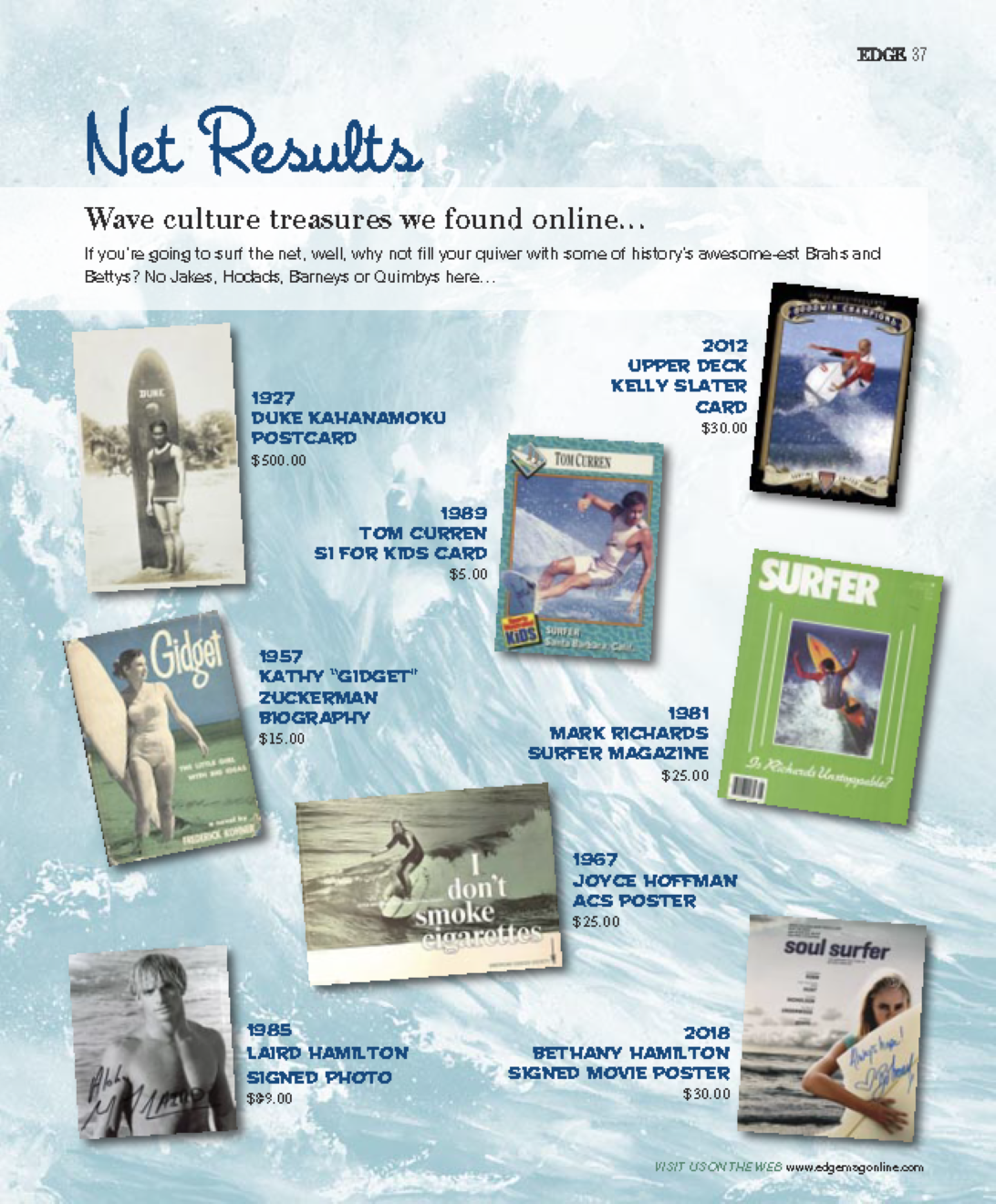
EDGE takes you inside the area’s most creative kitchens.
 Sonny’s Indian Kitchen • Sonny’s Butter Chicken
Sonny’s Indian Kitchen • Sonny’s Butter Chicken
225 Main Street • CHATHAM (973) 507-9462/9463 • sonnysindiankitchen.com
Sonny’s butter chicken is one of the best, delicious, smooth buttery and richest among Indian curries. It is made from chicken marinated overnight and baked in a clay oven then simmered in sauce made with tomatoes, butter and various spices.
— Chef Sonny
 The Thirsty Turtle • Pork Tenderloin Special
The Thirsty Turtle • Pork Tenderloin Special
1-7 South Avenue W. • CRANFORD (908) 324-4140 • thirstyturtle.com
Our food specials amaze! I work tirelessly to bring you the best weekly meat, fish and pasta specials. Follow us on social media to get all of the most current updates!
— Chef Rich Crisonio
 The Thirsty Turtle • Brownie Sundae
The Thirsty Turtle • Brownie Sundae
186 Columbia Turnpike • FLORHAM PARK (973) 845-6300 • thirstyturtle.com
Check out our awesome desserts brought to you by our committed staff. The variety amazes as does the taste!
— Chef Dennis Peralta
 Common Lot • Wagyu Beef Tartar
Common Lot • Wagyu Beef Tartar
27 Main Street • MILLBURN (973) 467-0494 • commonlot.com
Our wagyu beef tartar is paired with a Singapore style pepper sauce, summer herbs and flowers and sea beans.
— Head Chef/Owner Ehren Ryan
 The Famished Frog • Mango Guac
The Famished Frog • Mango Guac
18 Washington Street • MORRISTOWN (973) 540-9601 • famishedfrog.com
Our refreshing Mango Guac is sure to bring the taste of the Southwest to Morristown.
— Chef Ken Raymond
440 Parsonage Hill Road • SHORT HILLS (973) 467-8882 • par440.com
It’s pan seared and served over corn, black beans, peppers, celery and pineapple, with a corn coulis sauce.
— Chef Pascual Escalona Flores
Galloping Hill Road and Chestnut Street • UNION (908) 686-2683 • gallopinghillcaterers.com
Galloping Hill Caterers has been an incredible landmark for over 70 years. We pride ourselves in delivering “over the top” cuisine, impeccable service and outstanding attention to detail. That is the hallmark of our success! Simply, an unforgettable experience. Pictured here is one of our crepes flambé that really creates lots of excitement!
— George Thomas, Owner
Welcome Back!
The restaurants featured in this section are open for business and are serving customers in compliance with state regulations. Many created special items ideal for take-out and delivery and have kept them on the menu—we encourage you to visit them online.
Do you have a story about a favorite restaurant going the extra mile during the pandemic? Post it on our Facebook page and we’ll make sure to share it with our readers!
For bunion and hammertoe sufferers, minimally invasive surgery is where the rubber meets the road.
Your feet are not tires. When they wear out, there is no replacing them. That being said, there are a number of painful podiatric conditions that can now be resolved with minimally invasive surgical procedures. It’s not like purchasing a brand-new set of Michelins, of course, but in many cases the end result is a smooth, bump-free “new tire” feel. Two of the most common foot deformities, in fact, are now correctable through a tiny, two-millimeter incision: hammertoe and bunions.
These specialized techniques have been around for a while, notes Dr. Aqsa Siddiqui, DPM, who performs the surgeries at Trinitas, however, “not many podiatrists have been trained in this procedure, so it’s not done at every hospital. It has an excellent track record and very high rate of success, so as a result, we’re seeing more and more podiatrists being trained now. Bunions and hammertoe are different deformities with different plans, of course. However, we are able to treat both with minimally invasive surgery and correct each of those problems.” Hammertoe is a biomechanical imbalance in the foot, due to an imbalance of muscles at the top and bottom of the foot, which causes contraction, typically at a toe’s middle joint. It is a democratic (small d) condition that breaks roughly 50-50 male/female, from all ages and walks of life, and from all nationalities and cultural backgrounds.
“We do see a fair number of young people with this condition,” Dr. Siddiqui says. “But typically my patients tend to have had the condition for a very long time—10, 20 even as long as 40 years—and it is causing constant pain and discomfort. They have already gone through other options, including trying different shoes with, say, a more spacious toe box, or orthotics or other conservative treatments, but nothing has helped.
Now they need something a bit more aggressive to correct the deformity.” Minimally invasive hammertoe correction involves a two-millimeter incision, through which podiatrists trained in this technique can go in and release the tendon and capsule, and then make small cuts to the bone to bring the toe up and reposition it properly, so it is no longer contracted. The surgery doesn’t involve any screws or plates; a special splinting of the toe is added within the post-operative dressing, and the bone naturally heals in the correct position within a few weeks. If a patient has multiple hammertoes, Dr. Siddiqui says she prefers to do one toe first and monitor how it responds to the procedure. “After that,” she says. “I will do the remaining ones together.”
The traditional surgery to correct hammertoe involves a recovery time up to six weeks for the toe to fully heal. The recovery time for the minimally invasive procedure, by contrast, is very quick. The patient leaves the hospital or surgical center in a walking boot (so there is no real down time) and the post-operative pain is minimal. A few days of Motrin usually quells any discomfort. The splint is removed after a week and, after two weeks, patients transition into a surgical shoe and can begin range-of-motion exercises. Between two and four weeks, they are fully healed. After that, they are good to slowly return to normal activities, including sports.
Dr. Siddiqui’s affiliation with Trinitas dates back a decade. After graduating from the New York College of Podiatric Medicine in 2012, she completed her three-year residency at TRMC. From there she accepted a wound-care and limb-salvage specialty fellowship before returning to Trinitas as an attending physician, working with residents and performing minimally invasive procedures. She began gravitating toward this specialty after her uncle, who lived in Pakistan, suffered a wound on his toe and ended up having to have it amputated. “I was studying here at the time,” she recalls, “and I think that was probably what got me interested in podiatry. I soon realized that it’s a great field. There is such a variety of things you can do to help people and make a difference…and still have your own personal life.”
The recovery time for minimally invasive bunion correction is similar to that of the hammertoe procedure: You’re walking out of the hospital in a boot, which you’ll wear for a week or two, before transitioning into a shoe. Within four weeks, patients are fully healed. Whereas the causes of hammertoe tend to be consistent, not all bunions are created equal. The people limping into Dr. Siddiqui’s office may have developed bunions from a lifetime of repetitive stress or a genetic predisposition or as a result of flat feet—or some combination of causes. A mechanical imbalance of the muscles and tendons can also cause the deformity. Bunions are sometimes bilateral, but usually one foot is more severe than the other. What is unusual about the human foot that makes a bunion likely to form where it does, in the metatarsophalangeal joint of the big toe?

www.istockphoto.com
“The MTP joint is a very important joint that we use when we’re walking,” Dr. Siddiqui explains. “We roll off that joint. When there is an imbalance of the muscles, it can deviate that joint, causing that deformity. This in turn can cause damage to the cartilage in that area. Over time, the natural progression is that the big toe moves inward, overlapping or underlapping the second toe, or just squeezing against it. If the condition is not corrected, it progresses further and further into a severe deformity.” Traditional corrective surgery for bunions often involves opening up the entire toe and inserting plates and screws—frankly, to the layman it can sound a bit medieval.
Plus, there are occasional healing issues and complications and in some cases the pain and the bump can return after a certain amount of time. That is one reason bunion sufferers tend to opt for more conservative fixes, even before considering a minimally invasive procedure. Dr. Siddiqui is on board with this approach. “When a patient comes to me with pain in that joint, we like to begin with conservative treatments—injections, orthotics, physical therapy, comfortable shoes,” she says. “But if that isn’t helping, or if the pain returns, then surgery is an option.”
As with the hammertoe procedure, the bunion surgery involves a two-millimeter incision, through which a tiny drill can go in and shave off the bump, after which a cut can be made in the bone in such a way that it enables the surgeon to move the head of the metatarsal and reposition the toe. The technique involves a specific cut at a specific angle, which can be accomplished through the tiny incision. Can bunions come back? “Sometimes bunions do come back,” she says, “but from what I’ve seen—and this is echoed by other podiatrists who have been doing this for many years—compared to traditional surgeries, patients undergoing the minimally invasive procedure do really well in that regard.” So when is it time to kick the tires on bunion correction surgery? That’s an individual choice, of course.
And yes, Dr. Siddiqui is aware that there are folks out there who think they’ll just tough it out. “However, they should be aware that bunions don’t go away and tend to get worse,” she cautions. Indeed, the road to a more severe deformity can be paved with nerve damage, pain in the other toes, bursitis and eventually arthritis. Unfortunately, at the point when cartilage damage has progressed to where the joint doesn’t move anymore (hallux limitus), your options for a u-turn will likely be few and far between.
Editor’s Note: Dr. Aqsa Siddiqui, DPM, performs all of her minimally invasive procedures at Trinitas. She is in private practice in Carteret at The Foot Care Center of New Jersey, (908) 652–6077.
Not surprisingly, the devil is in the details.

www.istockphoto.com
Most of the things we spend money on combine two elements that determine their pricing or worth: the utilitarian and the subjective. While a refrigerator is more useful than a masterpiece painting, it holds a much lower market value. One is practical and common, the other is aesthetical and unique. Once any society has enough material goods to meet its basic needs, it starts to create (and assign value to) things that have no utilitarian purpose. The entire art industry, for example, exists only because a consensus of people decides that this painting or that sculpture is aesthetically valuable…and therefore it is valuable. Every so often, the perceived value of a particular product triggers a trend, which can explode into a collective “mania.”
An NFT, which is short for Non-Fungible Token, simply enables people to go crazy over a non-physical thing.
Spoiler alert: This may be the only “simple” idea in the pages that follow.
A year ago, I penned a feature for EDGE that attempted to explain cryptocurrencies in general, and Bitcoin in particular. The assignment was to make the article informative and entertaining. I am told the story received very positive feedback from readers who wanted a rudimentary explanation of them from someone who started with a rudimentary understanding of the topic. From that rudimentary understanding, my personal conclusion was that—owing to my wariness of the underlying fundamentals and my suspicion of all the hype—it was not for me. Since then, despite the best efforts of Larry David, Matt Damon, and other celebs who hopped aboard the crypto train, the dollar values of many cryptocurrencies, including Bitcoin, have plummeted by two-thirds or more.
In that story, I did not mention Ethereum, a second major player in the business, which is similar to—but not a carbon copy of—Bitcoin. Ethereum operates on a newer form of blockchain that has set off the latest round of speculative bedlam by introducing to the crypto universe a “digital asset” called an NFT. I wasn’t exactly shocked when EDGE called and asked me to take a shot at explaining NFTs to the magazine’s readers.
So what is an NFT? First off, let me say that I’m neither the first person nor the last to attempt a brief, simple yet coherent answer to this question. Let me also say that, in a world saturated with mis-, dis- and mal-information, much of what I encountered online while researching and writing this story was problematic—and in the case of one NY-Metro newspaper, mostly wrong.
Let me take you back to where I started: the drawing board. While I do, however, keep in mind something Ayn Rand once said: “Greed is the desire for the unearned.”
NFT By the Letters

www.istockphoto.com
Let’s start with the F in NFT: fungible. It’s an adjective with a textbook definition: “Of goods contracted for without an individual item being specified, replaceable by an identical item…or mutually interchangeable.” A bag of salt is fungible. If you want one, any one will do. Picasso’s Guernica? There is only one. This is where the N in NFT comes into play. Guernica is non-fungible. Non-fungible things tend to be more valuable than fungible ones.
Can a fungible item “become” non-fungible? Indeed it can. Think of an 8 x 10 publicity photograph of Tom Cruise, which might be printed in the hundreds or thousands. These are fungible. However, once Tom signs one of these photos, that single autographed print is technically unique and non-fungible—although you could argue that one Cruise scrawl is no different than another. Nonetheless, it would certainly be more valuable.
Now let’s talk about the T in NFT. It stands for Token, though not the kind you used to use on the subway or move around a Monopoly board. In this context, a token is a unit of value that is recorded as a receipt on something called a blockchain; if you’ve heard of NFTs or cryptocurrency, you’ve no doubt encountered this word. The people who use it toss it around as if everyone else obviously knows what it means…which is not the case…because it’s incredibly complicated. I offered an explanation of the blockchain in my cryptocurrency story last year and I think I’ve gotten a bit better at it since then. Here goes:
Let’s say that you want to buy a pair of shoes from Bob’s Boutique, which charges you $100. You don’t have cash, so you insert your debit card. The terminal sends a message to your bank that says I have an account with you and want to spend $100 at Bob’s Boutique… please send $100 to Bob’s bank. This is the meat and potatoes of what banks do millions and millions of times all day, every day, meticulously recording every transaction. At the end of each day, they tally up all the transactions and settle the accounts; your account balance is reduced by $100 and Bob’s is increased by $100. We trust our banks to keep perfect records, which is why we call them fiduciaries. It’s a system that’s been around since Renaissance Italy, and it works pretty well. With the advent of Internet 2.0 and the 2008 financial crisis (when a lot of folks had their faith in banks shaken), some brainy computer expert types started to wonder if there might be a way to create equally perfect and trustworthy records for these gazillions of transactions, but without those fiduciary third parties, the banks. Thus was born the blockchain.
A blockchain accomplishes the same accounting task as banks. However, instead of using two private ledgers for the buyer and the seller, all transactions are recorded together on the Internet, in a single, unalterable public ledger. In the crypto universe, Bob charges you the same price for your shoes (let’s call it 100 “coins”). You use your “crypto wallet” to move 100 coins into Bob’s account, and the transaction is recorded on your crypto coins’ blockchain. A large number of computers around the world maintain and monitor the blockchain ledger, in real time, 24 hours a day. All of those computers then confirm and approve your transaction.
A few years ago, the folks at Ethereum looked at this and saw that an adaptation of the blockchain ledger technology could be used to keep track of—and certify ownership of—a digital file, such as a Tweet or a JPEG or a GIF, by attaching a unique digital certificate to its purchase/sale transaction entry. That certificate is called a token—hence the T in NFT—and if said certificate is unique, it is also non-fungible: the NF in NFT. It tells the world that you own the original version of whatever that file happens to be, even if someone else copies or steals it.

The Value Proposition
How does one determine the value of an NFT? This is where I join you in a little head-scratching. Boosters of NFTs say that they’re like unique collectible cards that anyone can see online, but only one person can claim ownership of them at any given time. The concept behind an NFT is that this scarcity—which exists, is recognized and is understandable in the physical world—will confer a similar value in the virtual world of the Internet.
Can an NFT be copied? Yes. However, the original NFT address can be traced back to the original creator, since all NFTs have an indelible record of their transaction history on the blockchain. One of the current criticisms of NFTs, however, is that unlawful copies can be difficult to detect and police.
I know. I give up, too. But let’s keep moving.
There are four principal metrics of NFTs that determine their potential market value:
1) Primacy. Just as Bitcoin became the dominant cryptocurrency because it was the first, the first NFTs minted by certain creators and businesses tend to hold the highest perceived value. For example, Jack Dorsey’s first Tweet. You may have heard of the Bored Ape Yacht Club. It was the first “gallery” of digital art that caught the imaginations of celebrities and other people with way too much disposable income, and has since benefited from this caché, with prices for a cartoon ape bringing six- and seven-figure prices on OpenSea (more about that on the next page).
2) Scarcity. Think of a masterpiece painting. Everyone can have a copy of it and tack it up on their dorm room walls, but only one person (or museum) can hang the original. Or let’s say Madonna minted only one NFT ever—maybe a video file from her new documentary Madame X—but then tragically perished in a plane crash. Since there is only one, it might potentially become very valuable.
3) Provenance. Let’s say that Mark Wahlberg donates a leather jacket to a charity auction. It may have cost him $500 brand new, but now it’s just used clothing. Or is it? Because it’s celebrity used clothing, his fans might be willing to pay thousands for it. Now suppose that Mark wants to donate an NFT for a JPEG photo of himself and his family. Wouldn’t those same fans fight over that photo?

Gabbo T
4) Utility. Imagine if Taylor Swift sold 50 (and only 50) NFTs that granted their owners lifetime back-stage access to all of her live performances. These 50 NFTs would soar in value due to their real-world benefits. This is an example of a “smart contract,” which is an interesting quality of an NFT. Personally, I regard this as the only rational use for an NFT.
All four metrics are entirely dependent on the principle of “digital ownership.” NFTs are the digital equivalent of personal property. They reside in an owner’s crypto wallet, and for the most part can be used however and wherever the owner wants. If the “Metaverse” (uh-oh I see a third EDGE assignment coming!) takes off as the tech world believes it will, NFT “objects” will be used more and more in video games or other interactive situations where they would have monetary value.
Nuts and Bolts

www.istockphoto.com
How do you buy an NFT? Most are sold on marketplace web sites similar to eBay but specializing in NFTs, among them the aforementioned OpenSea. The vast majority are only available to be purchased using Ethereum, so you will need to own some Ether, the cryptocurrency developed by Ethereum to be just as dependable, but a little more nimble, than Bitcoin. Establishing a crypto wallet requires a degree of technical skill and, if you make a mistake, you might very well wind up losing your NFT, as well as your Ether.
Step 1: Create an account wallet on the NFT marketplace website of your choice
Step 2: Create an account wallet and purchase Ethereum on an exchange website
Step 3: Transfer your Ethereum from your exchange wallet to your marketplace wallet
Step 4: Bid in the auction for the NFT of your choice. If you win, that NFT is added to your marketplace account wallet. Where do you store your Ethereum and your shiny new NFT? The best place is on a third, offline “hardware wallet.”
Given how fast the NFT craze grew in 2021, you knew there would be some technical glitches. Some have been expensive. In one case, digital thieves were able to exploit a loophole in OpenSea’s exchange and snag an astronaut Bored Ape for $700,000 less than the asking price—and then flip it to another buyer for a quick profit.
Today there are tens of thousands of NFTs of all kinds—for visual art, music, sports videos… you name it. Since about 18 months ago, people have been buying all kinds—sometimes for boatloads of Ether. In March 2021, an NFT of a single JPEG image file sold at Christie’s auction house for $69 million worth of Ether. One month later, an NFT of Jack Dorsey’s first Tweet on March 22, 2006 (the very first Tweet) was bought for $2,915,835.47 (fun fact: it’s a prime number). An NFT of a LeBron James highlight video file sold for $208,000 just over a year ago.
It gets weirder. A 12-frame animation GIF by artist Chris Torres of a NYAN Cat with a frosted Pop Tart body flying through outer space, trailing rainbows behind it, sold for $600,000. Thousands of ape pictures created by Bored Ape Yacht Club (BAYC) are still generating hundreds of millions of dollars and are owned by some of the world’s most recognizable celebrities—including Snoop Dogg and Paris Hilton.
If you’re asking yourself just now: How are there so many idiotic NFT things that you’ve never heard of raking in so much lucre? Well, I’m with you. As a rule, anything two mental giants like Paris Hilton and Snoop Dogg are fascinated by, I turn from and run. Finally, here are my personal conclusions and, fair warning, they’re not favorable…
NFTs have all the earmarks of a scam IMHO (in my humble opinion)—a speculative bubble rife with ethical and financial rabbit holes. A “greater fool” game, if you will. It reminds me of what happened in the online retro games market not too long ago, when a bunch of dishonest guys bought each other’s collections to increase their perceived value—a practice known as “wash trading.”
NFTs depend on creating perceived value by fabricating scarcity that is normally found in physical objects. My question is, why restrict an infinitely reproducible digital file’s reproducibility unless you plan to sell it? Or, more precisely, resell it? You don’t buy an NFT to hang on your wall. You really can’t even keep other people from looking at it, if they want. You hope that its perceived value increases so you can dump it and make a profit.
If that sounds like stocks, bonds, commodities futures, etc. that are also speculative, it’s meant to. But trading in NFTs reminds me more of the old 1960s Milton Bradley party game, Time Bomb, where someone wound up the ticking egg-timer fuse on an explosive device and you’d pass it around a circle until it went off in some poor kid’s hands. It’s gambling, only with worse odds—like sitting down to a rigged poker game where the dealer and the other players are all working for the house.
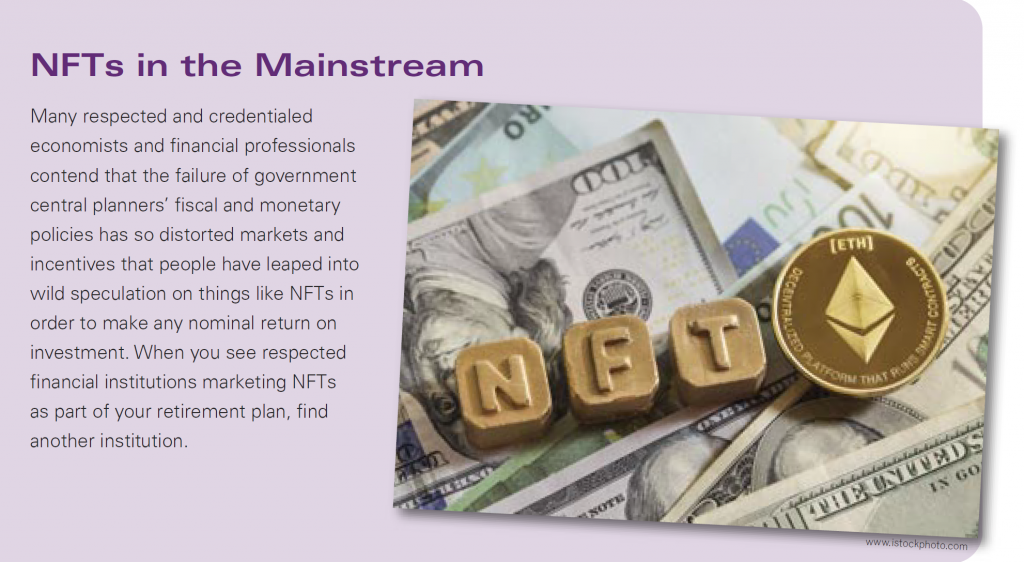
So What Is an NFT, Really?
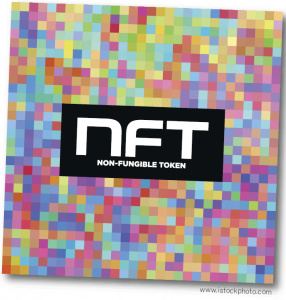
www.istockphoto.com
It is not much more than a gilded receipt for a digital luxury item. An original physical artwork is distinct from a reproduction; if you value that artwork, then there is genuine subjective benefit in owning it. But with digital art, reproductions are inherently perfect copies, so “original” means nothing. Anyone other than the owner can access and copy an NFT. The person copying it just can’t own it. In some cases, an NFT buyer doesn’t even get a traditional copyright (the buyer of the NYAN Cat, for example, did not receive the right to reproduce or merchandise the image from the artist). Meanwhile, many artists excited by NFTs’ potential as a revenue stream watched in dismay as their artwork was turned into unauthorized NFTs and sold without their knowledge or permission, in a market sorely lacking in effective oversight. That being said, among the most ardent supporters of NFTs as “the next generation of art” is Time magazine and its Timepieces Community, which features more than 20,000 NFTs.
NFTs might serve a use as a digital representation of a physical object, like a concert ticket—and are potentially great vehicles for money laundering. Otherwise, in and of themselves, I feel they are pointless.
NFT? No Freaking Thanks.
Editor’s Note: Luke Sacher is a documentary filmmaker who has written extensively on technology and popular culture for EDGE. Since he was assigned this story late in 2021, sales of NFTs have fallen more than 70%.


 After almost 60 years, do you enjoy the whole thing of being on tour, waiting for the concert?
After almost 60 years, do you enjoy the whole thing of being on tour, waiting for the concert?
It’s no big drag to travel around. You get to see people that you haven’t seen for a long time…hanging around with musicians and good friends. [The concert] is just something that you do at the end of the day. Actually, I’m quite happy to do it 60 years. After all, what else would I do? [laughs] I made this job up because I couldn’t think of anything else. I’d make a lousy plumber, you know? I’m very fortunate in finding what I wanted to do—and what I could do—very, very early in life and there’s never been any real doubt about that. So, in that case I’ve been very fortunate and give thanks and praises for it.
Did the passing of [drummer] Charlie Watts bring [the band] closer?
Yes, I do think so. When things like that happen, you do tend to draw together more, which I think is for the best of the band. The Rolling Stones are far bigger than any of its parts, you know. I always feel like I’m working for the Rolling Stones. I have no choice, I have to do this…I’m not complaining, I gotta say that. I’m sitting here, I’m ready to go to work.
I think the older you get, the healthier you become. Do you wonder about this yourself?
You know, if I ask questions about it, I might not like the answers. I’m just a fairly old bloke in pretty good shape. I spent half of my life taking up [unhealthy things] and half of my life giving them up. I don’t recommend this for everybody. I’m far from being indestructible. I just don’t break easy, you know?
Was smoking the hardest thing to give up?
I’d given up things far more addictive than nicotine. Actually, once I started doing it, I found it very easy. I stuck on the patch and said, “No more!” I know this doesn’t work for everybody. I’d tried to cut down smoking, but by the end of the week I’d find I’m smoking more. I really got disgusted with it eventually…and that was it. I found I had more stamina after that. Yeah, it’s definitely good. Give it all up. It’s good for you.
I get the impression that you are actually very young, a young spirit, a young man at heart.
I hope so. I’m holding out for my age as much as I can.
Are your grandkids curious about their granddad’s adventures in rock ‘n roll?
They are not old enough to know who I am. This is an incredible process, watching the little things grow up. I love ’em all. Yeah. I’m a grandfather, okay. [laughs]
Editor’s Note: Keith Richards turned 78 last winter. He formed The Rolling Stones with Mick Jagger and Brian Jones in 1962. The Stones are currently on a (briefly COVID-delayed) summer tour of Europe. This Q&A was conducted by Ken Summit of The Interview People.
What lies beneath may surprise you.
When the world imagines New Jersey, it pictures the opening drive from The Sopranos, an hours-long Bruce Springsteen concert, prizefights in Atlantic City, Tilly’s grin and the Asbury Park Boardwalk, Jersey Shore the reality show and Jersey Shore the beloved summer destination. New Jerseyans know better—there is a lot more to the state than meets the eye. For instance, we are surrounded by water on three sides, not just one, and our lakes and rivers offer endless opportunities for recreation. Something New Jerseyans may not know is that, under the surface of these picturesque bodies of water, there is a world of forgotten history, hidden secrets, and tantalizing clues to the past.
The Ice Age is a great place to begin our deep dive. During this period in Earth’s history, the frigid climate trapped a lot of the planet’s water in massive ice sheets, which in turn led to significantly lower sea levels—as low as 400 feet or more. The Atlantic coast extended far beyond what we now think of as the Jersey Shore. The Hudson River, meanwhile, didn’t end at Staten Island; it continued to cut through the exposed land for hundreds of miles, creating canyon three-quarters of a mile deep. We know it as the Hudson Canyon, a favorite fishing spot that also happens to be the largest known underwater canyon in the world. Too bad no one was around to see it back then.
Off the Hook
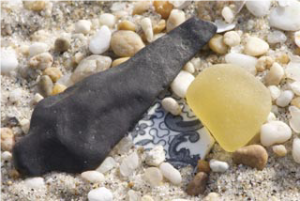
Guy Fleming
Well, hang on a minute. Do we know with absolute certainly that this land was unpopulated? The Ice Age ended and ocean levels began rising rapidly around 11,500 years ago. There is compelling evidence that humans had reached the Atlantic coast by then, which might have been 100 or more additional miles to the east. Called Paleo Indians by anthropologists, they would have hunted various now-extinct animals, including megafauna species that include mastodons, wooly mammoth and giant ground sloths. Evidence of their actual settlements would have been wiped away by the rapid rise of the ocean. However, fossilized animal bones are occasionally recovered far off shore, confirming that what we think of as the “sea floor” was once teeming with animals in the not-too-distant past.
In the 1990s, an ambitious dredging operation took place at the northern end of the coast to replenish eroding beaches. Much of the sand scooped up from a mile or more offshore was deposited in front of the towns of Sea Bright and Monmouth Beach—where beachcombers soon discovered hundreds of human artifacts, including stone tools and projectile points that pre-date the Lenape Indians who had inhabited the area before the coming of European settlers. These items appear to have been produced by the aforementioned Paleo Indians, at an offshore site that is believed to date back at least 10,000 years. The Paleo Indians spread across North America after arriving from northeast Asia via Beringia, the Ice Age land mass now submerged below the Bering Sea. When you stand facing the ocean, holding one of these ancient artifacts in your hand, it is impossible not to wonder what else is out there under the waves.

On the Lake Front

Upper Case Editorial
New Jersey’s lakes and ponds guard their share of secrets—some ancient and others from recent history. In 1954, Gus Ohberg, owner of a Sussex County sports shop, decided to expand the small lake on his property in Vernon Township. During the dredging, one of the workers spotted a large brown bone, which turned out to be a mastodon skull. Professionals were summoned to the site and eventually they uncovered the most complete mastodon skeletons ever found. The Ohberg Mastadon—renamed “Matilda” after the bride of one of the archaeologists on the project—was reassembled in Trenton, where it remains a favorite attraction at the State Museum more than six decades later. Matilda was a young female, a teenager, whose remains were carbon-dated to around 11,000 years old—near the end of the mastodon’s reign over North America, likely due to a combination of human hunting, disease and loss of habitat brought on by the end of the Ice Age, when the glaciers that carved through the northern half of New Jersey receded. Matilda may not have been the only member of her family to perish on the Ohberg property. Indeed, rumor has it that Mastodon Lake may have more secrets to reveal.
If you enjoy a mystery, know that the Round Valley Reservoir (right) in Clinton has been called “New Jersey’s Bermuda Triangle.” Since it opened to the public in the 1970s, more than 20 people have lost their lives swimming, boating and exploring there. People can’t resist a spooky story and, indeed, some insist the reservoir is cursed. Its allure to scuba divers, however, is the town that lies beneath its 55 billion gallons of water. The reservoir was completed in 1960, submerging a small farming community in the process. The project was initiated to meet Newark’s growing demand for water and Round Valley seemed like the perfect place to locate a reservoir.
All but one county (Hunterdon, where it was located) agreed, triggering eminent domain. Appraisers were sent to evaluate the 50 or so farms in the way so that the state could make an offer to residents that they literally couldn’t refuse. Some took the money and started anew. Others used a portion of the cash to re-purchase their family homes and then dismantle and physically relocate them. After it was all said and done—and tens of billions of gallons of water flooded the farms—the unthinkable happened: Newark pulled out. For the uninitiated, Newark’s relationship with its water supply has been historically (and often criminally) complicated, to say the least, and remains so. Thankfully, Round Valley still serves a purpose, as the water it sends through an underground pipeline makes its way to the Raritan River. And, as mentioned, it is a popular recreation and relaxation spot. Scuba divers can explore the foundations of many houses, a church, and a school—and maybe even spot a skeleton or two. It’s like New Jersey’s own little Atlantis.
Near the Shore

Deathworm
For more than three centuries beginning in the 1600s, the New Jersey coast was known unofficially as the graveyard of ships. Today, it has more shipwrecks per mile than any other state. Prior to the dredging of the current shipping channel in the 20th century, the approach to New York harbor was not a straight shot. Ships coming north had to hug the shoreline to remain in deep water, passing uncomfortably close to Sandy Hook in order to reach the Verrazano narrows. Vessels coming across the Atlantic had to aim directly at the shore and then make a hard turn to the right to find a channel deep enough to safely make it to port. An inexperienced captain or a violent storm could run a ship onto the sandbars, where it would be smashed to pieces.
One of the oldest wrecks off the coast of New Jersey is the HMS Zebra, a 14-gun sloop built by the British in 1777 to help crush the American Revolution. Its voyage ended abruptly in the fall of 1778 when the ship ran aground near Little Egg Harbor. The Zebra was part of the naval force controlling traffic in and out of the Delaware River, ensuring a constant flow of men and material to Philadelphia, one of the key cities in the colonies.
The struggle to control the waters around Cape May had been raging for two years by then. In the summer of 1776, the American colonists earned a critical early naval victory at the Battle of Turtle Gut Inlet, off Wildwood Crest. A spectacular American casualty in this meeting was the Nancy, a newly constructed brig that had sailed up from the Caribbean with a crew of 11, loaded with rum, sugar, gunpowder and arms. The British had already established a naval blockade of the area, with more than 200 cannons protecting the Delaware River. The Nancy (above) was spotted and pursued by a pair of British warships up the Jersey coast to the inlet, where it was purposely run aground so that longboats could be rowed out to salvage her precious cargo.

Winterthur Collection
The larger British vessels had to remain in deeper waters, but were close enough to fire on the salvage mission. The Nancy’s cannons fired back. When the offloading was complete, the Nancy’s flag was lowered, which the enemy took for a sign of surrender. Moments after boarding the disabled vessel, British forces discovered it was a trap: Using the Nancy’s mast as a fuse, the Americans had left 100 kegs of gunpowder aboard to blow her to splinters, sending more than a half-dozen redcoats to oblivion. The official seal of Wildwood Crest commemorates this event and the town also has a park with a memorial to those who served on the Nancy.
The wreck of the Nancy was a key moment in the early history of what was to become the U.S. Navy. Another maritime incident off the Jersey Shore gave birth to the U.S. Lifesaving Service, antecedent to the Coast Guard. A February 14th nor’easter in 1846 claimed several ships—some five off Sandy Hook alone—but it came to be known as the Minturn Storm. Among the casualties of the howling winds and driving snow was the Alabama, which ran aground near the Manasquan Inlet. A rescue attempt by ill-equipped locals failed and the crew perished. Many of the same good Samaritans turned their attention to the John Minturn, just four miles away in Mantoloking, later that day. The three-masted packet ship was carrying passengers and cargo from New Orleans when it slammed into the sand about 300 yards from shore. The rescuers worked for 18 hours and had more luck than with the Alabama, but there was still a tremendous loss of life. Only 10 people out of 50 survived and frozen bodies littered the beach.
No good deed goes unpunished and, sure enough, news stories reported that many of the bodies had their pockets turned inside out, calling the locals “barbarians.” The sensational tales triggered an investigation, which found that these people had risked their lives to save others, not to relieve corpses of their valuables. One account claimed that a body of a man wearing a gold belt buckle had washed up in Point Pleasant and was returned to his family still wearing the belt. The publicity generated by the Minturn Storm gave U.S. representative William Newell the momentum needed to push for the formation of an organized lifesaving corps. Two years later, the Newell Act called for the construction of a series of buildings to house the proper equipment to save people from wrecked ships. These Life Saving stations, which eventually popped up all over the east coast, were originally built along the shore from Sandy Hook to Little Egg Harbor, giving brave volunteers real equipment and a real chance of saving people.
Dan Lieb, president of the New Jersey Historical Divers Association, lists the John Minturn among the “Holy Grail” shipwrecks that he hopes to explore one day. Right up there with it is the New Era, which slammed into an outer sandbar off Asbury Park in 1854. Hundreds of passengers—mostly German immigrants—clung to the ship’s rigging, hoping to ride out the storm. Some made it, but most didn’t. About half of the 300-odd victims were interred in a West Long Branch cemetery, where a monument marks their mass burial. All kinds of rumors and controversy surrounded the wreck, most of which still linger to this day. Neither the John Minturn nor the New Era has been found yet—or, at least, not that Lieb knows. Often divers who discover a new wreck keep it to themselves.
By rough count, there are more than 5,000 sunken ships within 20 miles of the New Jersey coastline— hundreds of which can be explored by experienced divers. They include boats torpedoed during the two World Wars and victims of maritime collisions, an inevitable result of a busy shipping lane and unpredictable weather.
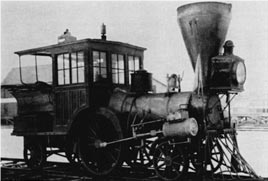
Upper Case Editorial
According to Lieb—who has completed over 2,000 dives since being certified in 1974—perhaps the most intriguing underwater wreck in New Jersey is not a shipwreck, but a trainwreck. A few miles off the coast of Long Branch, under 90 feet of water, two 1850s-era locomotives sit, nestled in the soft sand, side-by-side about 10 feet apart. Discovered in 1985, the trains are small (even for their time), weighing 15 tons apiece. The wheel layout is curious: three on each side, with the middle wheel larger than its neighbors. Their pattern of design (above) was common in England, Lieb points out, but a bell retrieved from the site raises the possibility that they may have been manufactured in Boston—or more likely the bell was added in Boston as the trains passed through New England on their way to their still-unknown final destination. It is not clear when the trains were lost, either. There are a number of scenarios that would pin their demise to a specific date, which could range from the 1850s to the end of the 19th century. For instance, the locomotives could have been headed to buyers in the Caribbean or South America, where rail systems were just being established, many decades after they were manufactured.
“Were they on their way to another country because they had become obsolete in America?” Lieb wonders. “I have visited them several dozen times. It’s quite interesting to see land-based vehicles underwater. They look so out of place.”
Another unknown is how the locomotives reached their final resting place. Obviously, they were being transported on a barge or some other vessel. But where is it? In 30-plus years of underwater exploring, no wreckage has been found. And what were the circumstances of their trip to the bottom? Did they break loose in heavy seas? Were they intentionally cut free, either to save the ship or perhaps to generate an insurance claim? Was it sabotage? None of these scenarios can account for the odd position in which they were found.
New Jersey’s waters have many more stories to tell. They provide snapshots of the past, protecting history from the elements of the surface world and preserving countless undiscovered treasures for future generations to explore.
Editor’s Note: The goal of the New Jersey Historical Divers Association (njhda.org) is to identify shipwrecks and bring their history to life. For those interested in exploring underwater New Jersey, a great starting point for new divers is to join a club or associate themselves with a dive shop and ask for recommendations.
OBJECT LESSONS:
From Ordinary to Extraordinary
With a bicycle seat and handlebars left on the side of a road, Picasso created “Head of a Bull,” famous icon of the artform Objets Trouvés—found objects. French-American artist Marcel Duchamp took a urinal, titled it “Fountain,” signed it, eh voilà!, another well-known icon of trouvé art. Ubiquitous things, such as shoes and plastic bottles, caught the poetic vision of artist Willie Cole. Put his two-dimensional works in the mix and observe the art made with a steam iron. And herein learn even more about the phenomenon called Artistic Seeing.
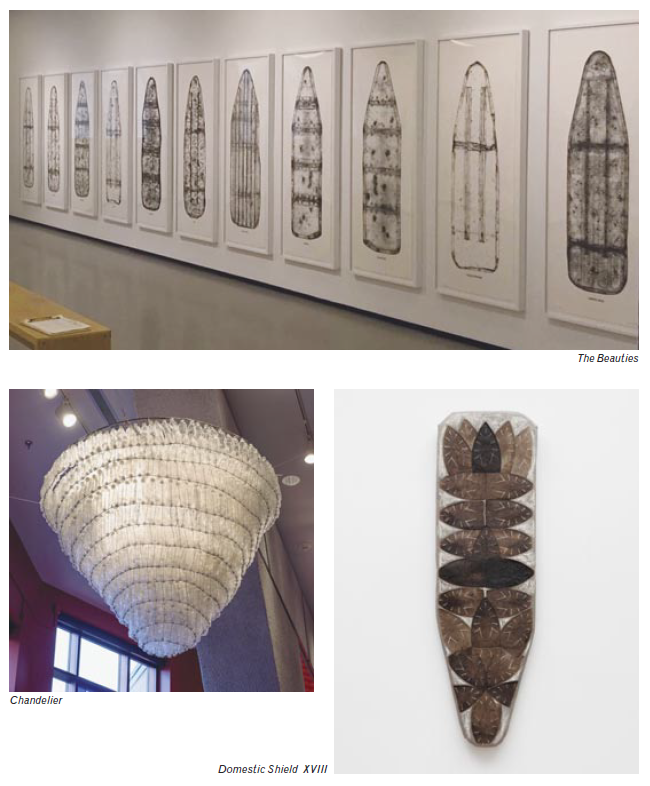


Portrait from the Heels Over Head series
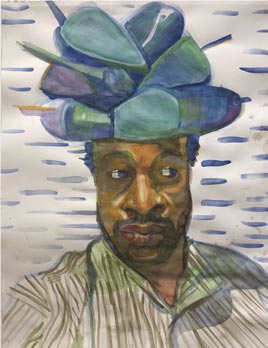
Portrait from the Heels Over Head series
About the Artist
 Born in 1955 in Somerville, Willie Cole, now living in the Morris County town of Mine Hill, NJ, infuses dynamism in ordinary objects built as African and other modern references. His sculptures, paintings and prints have been exhibited in the Museum of Modern Art and many other venues. A sculpture is in the Afrofuturist Period Room at the Metropolitan Museum of Art. His large-scale sculptures will be installed in the Kansas City International Airport in 2023. “My show at the Met’s Mezzanine gallery,” says Cole, “focuses on my print work with the steam iron. It’s a small show but a welcomed one.” Of course, you’ll never look at steam irons, plastic bottles, or shoes the same way again.
Born in 1955 in Somerville, Willie Cole, now living in the Morris County town of Mine Hill, NJ, infuses dynamism in ordinary objects built as African and other modern references. His sculptures, paintings and prints have been exhibited in the Museum of Modern Art and many other venues. A sculpture is in the Afrofuturist Period Room at the Metropolitan Museum of Art. His large-scale sculptures will be installed in the Kansas City International Airport in 2023. “My show at the Met’s Mezzanine gallery,” says Cole, “focuses on my print work with the steam iron. It’s a small show but a welcomed one.” Of course, you’ll never look at steam irons, plastic bottles, or shoes the same way again.
—Tova Navarra
Love it or hate it, New Wave has returned disguised as classic rock…and looks like it’s here to stay.
Music trends come and go. And often they come back again. Such is the case with New Wave, the genre that enjoyed a brief but notable heyday from the late-1970s to the late-1980s. A less-angry and more artistic offshoot of punk rock, New Wave was radio-friendly (remember radio?) and, at its height, helped launch the age of the music video. It was heavy on synthesizers, driving guitar and tinny percussion, light on traditional lyric structure. It ushered in a “second” British Invasion and launched the careers of several American rock superstars who are still making music today. And then, almost overnight, New Wave blipped out of existence, overtaken by an onslaught of grunge, rap, hip-hop, hair metal and electronic dance music—with many of its stars reemerging later on the alternative rock charts.
For tens of millions of Americans—most past 50 and many pushing 60—New Wave was the music they grew up on. It’s their classic rock, their comfort food. And, yes, you’re starting to hear those old riffs sampled in hip-hop tunes and in ads and played in the aisles of supermarkets and retail stores. It has its own Sirius XM channel and it’s probably just a matter of time until big pharma starts co-opting New Wave tunes for their drug commercials. Perhaps not surprisingly, the genre, which was the last sold primarily as vinyl, is also being rediscovered by hipsters, teens and tweens—often at the gentle urging of their parents or (yikes!) grandparents.
Alas, it would seem that we wrote off New Wave a bit prematurely. Turns out it was more than a pop-music flash in the pan. Its reemergence and staying power are testaments to the artistry and innovation of its creators. Who were they and where are they now? Here’s a look at ten of the best…
Blondie 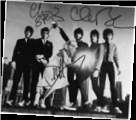
Way Back When…
Jersey Girl Deborah Harry and Brooklynite Chris Stein assembled Blondie in 1974 and ascended quickly to the vanguard of the New Wave movement. The band was popular abroad and in the dank music clubs of the East Village until their third album, Parallel Lines, blew up and made them bona fide superstars.
Big Hits
Heart of Glass, Call Me & The Tide Is High
Where Are They Now?
Blondie took a break in the early 1980s so that Stein could recover from a debilitating autoimmune disease, with Harry continuing to record as a solo artist. By the end of the decade, the pair had broken up as a couple. But Blondie re-formed in the late-1990s and produced the album No Exit, albeit to a lukewarm response. They continued to record and perform in the 2000s and were inducted into the Rock & Roll Hall of Fame in 2006. Harry and Stein announced a tour set to start in the spring of 2022, but the 72-year-old Stein ultimately stepped aside with heart issues.
The B-52s 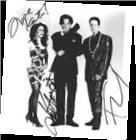
Way Back When…
The B-52s embraced a humorous, 1950s “trash-culture” ethos, with a mix of wacky lyrics and retro keyboard work. Kate Pierson and Fred Schneider handled vocals, while Ricky Wilson provided some memorable guitar licks.
Big Hits
Rock Lobster and Love Shack
Where Are They Now?
Although the B-52’s have toured more or less consistently—and put out new albums in 1992 and 2008—the band’s popularity faded in the mid-1980s following Wilson’s death from AIDS. They enjoyed a brief resurgence during the music-video boom with “Love Shack.” With Schneider and Pierson now both in their 70s, a farewell tour has been scheduled to begin later this summer.
The Cars 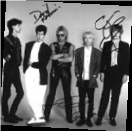
Way Back When…
The Cars were at the forefront of New Wave’s calling card of guitar licks plus heavy synthesizer, releasing their first album in 1978. Ric Ocasek, on guitar and vocals, had a unique look that proved ideal for the MTV generation. The Cars won Video of the Year award at the very first MTV Video Music Awards in 1984. Their strong, minimalist style powered multiple hits during the decade.
Big Hits
Just What I Needed, Shake It Up & You Might Think
Where Are They Now?
After the band broke up in the late-1980s, Ocasek married super-model Paulina Porizkova, who had appeared in a Cars video when she was 18. The couple was estranged in 2019 when she found him dead in their still-shared New York City brownstone at the age of 75, from heart disease. The band had been inducted into the Rock & Roll Hall of Fame the previous year. Cars bassist Benjamin Orr, who shared lead vocals with Ocasek on several hits—including “Just What I Needed”—passed away from pancreatic cancer in 2000.
Elvis Costello 
Way Back When…
After cutting his teeth as a pub-rock punk artist in the early 1970s, Costello made a splash in the early days of New Wave with My Aim Is True. He formed a band called The Attractions and pumped out a string of albums produced by Nick Lowe, including This Year’s Model, Armed Forces and Almost Blue—which demonstrated the depth and breadth of his talent and are still top-sellers today.
Big Hits
Alison, Angels Wanna Wear My Red Shoes & Pump It Up
Where Is He Now?
Costello became one of the most in-demand musical collaborators of his time, pairing with everyone from Paul McCartney to Burt Bacharach to Annie Lennox, and also demonstrated his acting skill in several film and television appearances. In 2003, Elvis Costello & The Attractions were inducted into the Rock & Roll Hall of Fame. He married chanteuse Diana Krall that same year and had twin boys.
Duran Duran 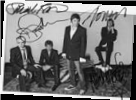
Way Back When…
The darlings of MTV in the network’s infancy, Duran Duran featured singer Simon Le Bon, bassist John Taylor, drummer Roger Talyor and keyboardist Nick Rhodes. They were one of the first bands to shoot their videos on 35 mm film and collaborate with established moviemakers. They won the first Grammy for Best Music Video in 1984 and rode their success to perform the title song to the 1985 007 film A View to a Kill.
Big Hits
Rio & Hungry Like the Wolf
Where Are They Now?
Constant reshuffling saw Duran Duran’s popularity ebb by the end of the 1980s. They continued to make music in the 1990s and experienced a resurgence in popularity in the 2000s, selling out show after show on tour in the US and UK. In 2012, they headlined at the Summer Olympics opening ceremony in London and in 2021 released the studio album Future Past to great fanfare.
Eurythmics 
Way Back When…
Annie Lennox and Dave Stewart broke off from The Tourists in 1981 to form Eurythmics, which blended electronic and psychedelic influences to produce a form of avant- garde pop that was utterly unique. After turning out their first album, Lennox suffered a nervous breakdown and Stewart nearly died from a collapsed lung. They recovered to produce Sweet Dreams, a huge success that also showcased Lennox as a music-video star.
Big Hits
Sweet Dreams (Are Made of This) & Would I Lie to You
Where Are They Now?
After issuing eight albums in eight years, Lennox and Stewart took a break for a decade to work on individual projects. They reunited in 1999 to record another album and appeared together sporadically thereafter, often as part of fundraising and tribute concerts. In 2019, Lennox released her eighth solo record, Lepidoptera.
The Police 
Way Back When…
What an interesting trio these guys were: Sting (trained as a teacher), Stewart Copeland (grew up in Beirut) and Andy Summers (a 35-year-old jazz guitarist) found one another in 1977 and formed the core of The Police. After making several top-selling albums on the international scene, the British band became New Wave megastars in America with the release of Synchronicity—their fifth and final studio album before breaking up in 1986.
Big Hits
Roxanne, Don’t Stand So Close to Me & Every Breath You Take
Where Are They Now?
The three key members of The Police decided to do their own things, and each continued to thrive. Sting sold millions of records as a solo artist and dabbled in acting—most recently in Only Murders In the Building, playing (and poking fun at) himself. Copeland, a transformative rock drummer, became a prolific composer of film scores and has written ballets and operas. Summers also turned out film scores—including Down and Out In Beverly Hills and Weekend at Bernie’s—and recorded a string of acclaimed jazz albums. Following their Hall of Fame induction in 2003, a reunion tour in 2007 sold out countless arenas.
The Pretenders 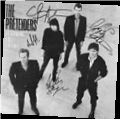
Way Back When…
Ohio-born Chrissie Hynde and Englishman Jimmy Honeyman-Scott blended their distinctly different musical styles to form the heart of The Pretenders in 1979. Hynde named the band after the Platters’ iconic hit “The Great Pretender.” They bowled over critics and developed an intensely loyal fan following, but the band was devasted in 1982 when Honeyman-Scott died of a cocaine overdose at age 25.
Big Hits
Don’t Get Me Wrong, Brass In Pocket & I’ll Stand by You
Where Are They Now?
Hynde reconstituted the band several times over, touring consistently and producing roughly one studio album per decade, including 2020’s Hate for Sale, which received a thumbs-up from fans and critics. In 2005, The Pretenders were inducted into the Rock & Roll Hall of Fame.
Talking Heads 
Way Back When…
Even when New Wave was new, Talking Heads were recognized as pioneers, blending punk, funk and world music into a dizzying array of hit songs and albums during a remarkable 16-year run that ended when the band broke up in the early 1990s. David Byrne, Tina Weymouth, Jerry Harrison and Chris Frantz explored percussion in its many forms and elevated winking, ironic lyrics to an art form—not surprising, as they all first met while art students in the early 1970s. Their 1984 film Stop Making Sense, directed by Jonathan Demme, is one of the most watchable concert movies of the 20th century.
Big Hits
Psycho Killer, Burning Down the House & Once in a Lifetime
Where Are They Now?
While his three bandmates toured in the 1990s without him as Shrunken Heads (!), David Byrne continued to make clever, sophisticated music and encouraged other musicians to remember that without “art” there is no artist. Among the performers that credit Talking Heads as a major influence are Vampire Weekend, Kesha, St. Vincent, Trent Reznor, Franz Ferdinand, Eddie Vedder, LCD Soundsystem and Radiohead, which actually took its name from one of the band’s 1980s songs. In 2019, Byrne starred on Broadway in American Utopia, which featured reimagined versions of several Talking Heads classics.
Tears for Fears 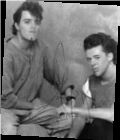
Way Back When…
Formed in the English city of Bath in the early 1980s, Tears for Fears was one of the lead bands in the so-called “Second British Invasion.” Band founders Roland Orzabal and Curt Smith were heavily influenced by the electronic music of Gary Numan (“Cars”) and Depeche Mode (“Just Can’t Get Enough”), as well as the lyrics of Peter Gabriel and David Byrne. They scored a pair of #1 hits in the U.S. in the mid-1980s and were huge stars on MTV.
Big Hits
Shout & Everybody Wants to Rule the World
Where Are They Now?
Success and “creative differences” drove Smith and Orzabal apart, leading to a break-up in the early 1990s. They reunited in 2000 and continued to tour and put out new music over the next two decades. In 2021, their album The Tipping Point reached #1 on Billboard’s Alternative chart and Tears for Fears is currently on tour here and in the UK.
Editor’s Note: As a teenager in the 1970s, Mark Stewart stumbled into several claustrophobic East Village clubs, where he was lucky enough to catch Blondie and Talking Heads. He also shared a house with the road manager of Duran Duran. David Byrne and Elvis Costello are still on heavy rotation in his CD player. (Remember CD’s?)
































